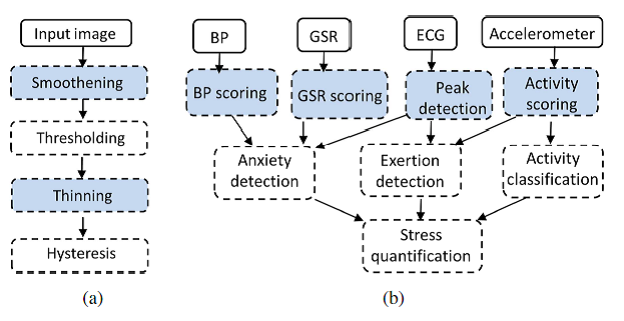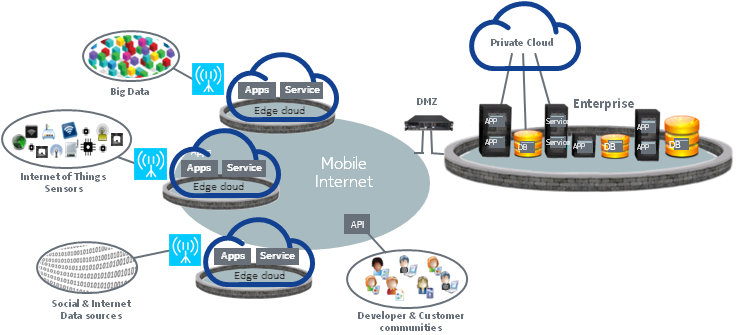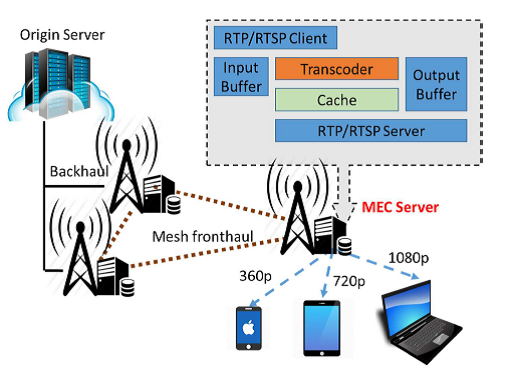Mobile applications are adopted and growing for every industry and market segment such as entertainment, business, education, health care, social networking, etc. Increased wireless application adoption is creating growth in mobile data traffic. As a result, Mobile data traffic is predicted to continue doubling each year. To keep up with these surging demands, network operators have to spend enormous efforts to improve users’ experience, while keeping a healthy revenue growth. To overcome the limitations of current Radio Access Networks (RANs), the two emerging paradigms have been proposed:
(i) Cloud Radio Access Network (C-RAN), which aims at the centralization of Base Station (BS) functions via virtualization
(ii) Mobile Edge Computing (MEC), which proposes to empower the network edge.
While the two technologies propose to move computing capabilities to different direction (to the cloud versus to the edge), they are complementary and each has a unique position in the 5G ecosystem.
As depicted in Fig. 1, MEC servers are implemented directly at the BSs using generic-computing platform, allowing the execution of applications in close proximity to end users. With this position, MEC can help fulfill the stringent low-latency requirement of 5G networks. Additionally, MEC offers various network improvements, including: (i) optimization of mobile resources by hosting compute-intensive applications at the network edge, (ii) pre-processing of large data before sending it (or some extracted features) to the cloud, and (iii) context-aware services with the help of RAN information such as cell load, user location, and allocated bandwidth. Although MEC principle also aligns with the concept of fog computing and the two are often referred to interchangeably, they slightly differ from each other. While fog computing is a general term that opposes with cloud computing in bringing the processing and storage resources to the lower layers, MEC specifically aims at extending these capabilities to the edge of the RAN with a new function splitting and a new interface between the BSs and upper layer. Fog computing is most commonly seen in enterprise-owned gateway devices whereas MEC infrastructure is implemented and owned by the network operators.
Fueled with the potential capabilities of MEC, we propose a real-time context-aware collaboration framework that lies at the edge of the cellular network and works side-by-side with the underlying communication network. In particular, we aim at exploring the synergies among connected entities in the MEC network to form a heterogeneous computing and storage resource pool. To illustrate the benefits and applicability of MEC collaboration in 5G networks, we present three usecases including mobile-edge orchestration, collaborative video caching and processing, and multi-layer interference cancellation. These initial target scenarios can be used as the basis for the formulation of a number of specific applications.
CASE STUDY: COLLABORATIVE VIDEO CACHING AND PROCESSING
Mobile video streaming traffic is predicted to account for 72% of the overall mobile data traffic by 2019, posing immense pressure on network operators. To overcome this challenge, edge caching has been recognized as a promising solution, by which popular videos are cached in the BSs or access points so that demands from users to the same content can be accommodated easily without duplicate transmission from remote servers. This approach helps substantially reduce backhaul usage and content access delay. While content caching and delivery techniques in wireless networks have been deployed extensively, existing approaches rarely exploit the synergy of caching and computing at the cache nodes. Due to the limited cache storage at individual BSs, the cache hit rate is still moderate.
With the emergence of MEC, it is possible to not only perform edge caching but also edge processing with artificial intelligence. Our approach will leverage edge processing capability to improve caching performance/efficiency. Such joint caching, processing and artificial intelligence solution will trade off storage and computing resources with backhaul bandwidth consumption, which directly translates into sizable network cost saving. See figure
Figure – MEC-processing for Video Optimization
Due to the heterogeneity of user-device processing capabilities and the varying of network connections, user preference and demand towards a specific video might be different. For example – Based on terrain information of area based on anonymously-coded location of the user-device and history of data-performance in a certain location, optimum data-rate options for a video streaming to a user can be estimated. AI-enabled MEC Solution can help create a highly differentiated user video experience by an operator instead of simply acting as a bit-pipe. Video content distribution can become integral part of operator network with value-added or localized services based on the location of MEC-server on which video content distribution is running. Example of localized video content at MEC is – Educational content, Local News, Local business information & reviews etc.
Case Study – Mobile Edge Collaboration
In spite of the limited resources (e.g., battery, CPU, memory) on mobile devices, many computation-intensive applications from various domains such as computer vision, machine learning, and artificial intelligence are expected to work seamlessly with real-time responses. However, the traditional way of offloading computation to the remote cloud often leads to unacceptable delay and heavy backhaul usage. Owing to its distributed computing environment, MEC can be leveraged to deploy applications and services as well as to store and process content in close proximity to mobile users. This would enable applications to be split into small tasks with some of the tasks performed at the local or regional clouds as long as the latency and accuracy are preserved. In this case study, we envision a collaborative distributed computing framework where resource-constrained end-user devices outsource their computation to the upper-layer computing resources at the edge and cloud layers. Our framework extends the standard MEC originally formulated by ETSI, which only focuses on individual MEC entities and on the vertical interaction between end-users and a single MEC node. Conversely, our proposed collaborative framework will bring many individual entities and infrastructures to collaborate with each other in a distributed system. In particular, our framework oversees a hierarchical architecture consisting of:
- end-user, which implies both mobile—and static—end-user devices such as smart phones, sensors, actuators,
- edge nodes, which are the MEC servers co-located with the BSs, and
- cloud node, which is the traditional cloud-computing server in a remote datacenter.
Our novel resource-management framework lies at the intermediate edge layer and orchestrates both the horizontal collaboration at the end-user layer and the MEC layer as well as the vertical collaboration between end-users, edge nodes, and cloud nodes. The framework will make dynamic decisions on “what” and “where” the tasks in an application should be executed based on the execution deadline, network conditions, and device battery capacity. See figure below for the example of Mobile-edge collaboration use-cases in which AI-enabled MEC can be used.
 Figure – (a) Computer Vision Use-Case (b) Health-Care use-case collaboration
Figure – (a) Computer Vision Use-Case (b) Health-Care use-case collaboration
In contrast, AI-enabled MEC introduces a new stage of intelligent processing such that the edge nodes can analyze the data from nearby user-devices and notify cloud node for further processing only when there is a significant change in data or accuracy of results. In addition, sending raw-sensor values from end-users to the edge layer can overwhelm the fronthaul links, hence, depending on the storage and compute capabilities of user devices, information processing of other near-by devices and the network conditions, the AI-enabled MEC can direct the user devices to extract features from the raw-data before sending to the edge nodes.


